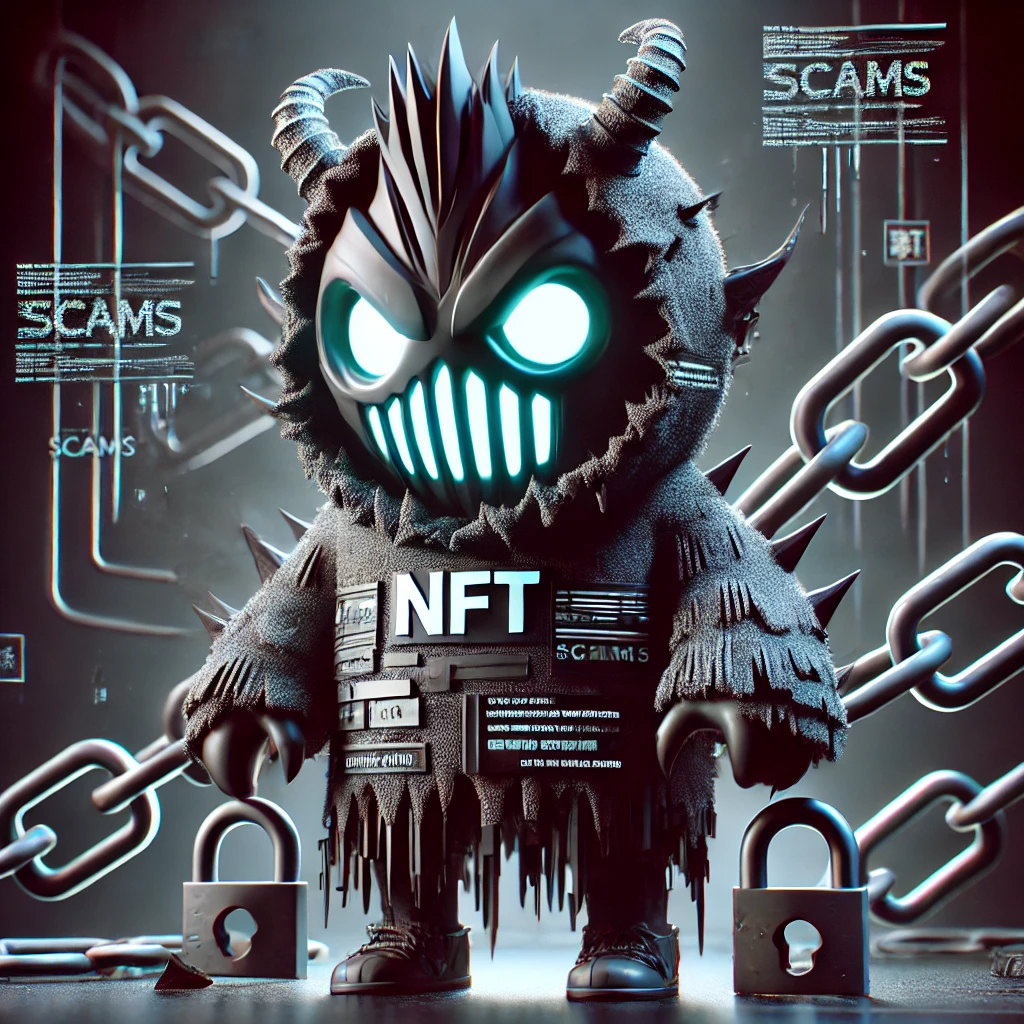The world of NFTs has exploded in recent years, enticing millions with the promise of digital ownership and financial gains. However, this exciting new frontier is also attracting scammers, who are eager to exploit the naivety and enthusiasm of newcomers. It is crucial to approach the NFT space with a critical eye and understand the potential pitfalls before diving in. This guide provides a comprehensive overview of common NFT scams and equips you with the knowledge and tools to protect yourself from falling prey to them.
Table of Contents:
Understanding NFT Scams: A Primer
NFT scams encompass a wide range of malicious activities designed to deceive users and steal their cryptocurrency, personal information, or valuable NFTs. These scams often leverage the hype and complexity surrounding NFTs to prey on the unwary. Here’s a breakdown of the most prevalent types of NFT scams:
Phishing Scams
Phishing scams are a classic tactic employed by scammers across various online platforms, and NFTs are no exception. They involve creating fake websites or emails that mimic legitimate ones, often associated with popular NFT marketplaces or projects. These deceptive platforms trick users into providing sensitive information like their login credentials, seed phrases, or private keys, granting scammers access to their wallets and assets.
Here are some telltale signs of phishing websites and emails:
- Misspellings or grammatical errors in the website address and content.
- Unusual or suspicious-looking email addresses.
- Urgent requests for personal information or action without a clear reason.
- Offers that seem too good to be true, such as guaranteed returns or free NFTs.
Rug Pulls
Rug pull scams involve developers of NFT projects abruptly abandoning the project and making off with the funds raised from initial investors. These projects often promise immense returns and feature alluring marketing strategies, attracting unsuspecting users who invest substantial amounts. Once the project reaches a critical funding level, the developers abscond with the money, leaving investors with worthless NFTs and a depleted wallet.
Here are signs to watch out for in potential rug pull scenarios:
- No clear roadmap or development plan for the project.
- Lack of transparency regarding the project’s team and their identities.
- Unrealistic promises of high returns on investment in a short period.
- Sudden spikes in trading volume and price followed by a steep decline.
Pump and Dumps
Pump and dump scams are coordinated efforts to inflate the price of an NFT collection before dumping a large amount of tokens into the market, causing the price to crash. These scams often involve coordinated efforts on social media and online forums to create hype and attract uninformed buyers. Once the price reaches its peak, the involved parties sell their holdings, triggering a sudden drop and leaving latecomers with significant losses.
Key characteristics of pump and dump schemes include:
- A sudden surge in the price of the NFT collection without apparent justification.
- Widespread promotion and hype on social media and online forums.
- Multiple accounts engaging in coordinated buying activity.
- An inexplicable drop in the price after the initial pump.
Fake NFT Marketplace Scams
In this type of scam, criminals create fake websites masquerading as reputable NFT marketplaces like OpenSea or Rarible. These fake marketplaces mimic the legitimate platforms’ design and functionality, enticing unwary users to list their NFTs for sale. Once the NFTs are listed, the scammers disappear with the assets, leaving the owners with nothing.
Here are some indicators that you might be dealing with a fake marketplace:
- Website address that is slightly different from the genuine platform’s URL.
- Suspicious or unprofessional website design and layout.
- Lack of customer support or contact information.
- Offers that seem too good to be true, such as a high selling price for your NFT.
Giveaway Scams
Commonly found on social media platforms, these scams promise free NFTs in exchange for users following a specific account, joining a Discord server, or engaging in other actions. The goal is to collect personal information from unsuspecting individuals. Once the scammers have gained enough information, they can exploit it for malicious purposes like identity theft or cryptocurrency theft.
Signs that a giveaway may be fraudulent include:
- A lack of verification or endorsement from the legitimate NFT project or creator.
- Requests for personal information beyond what is necessary for participation in the giveaway.
- A requirement to connect your wallet to a suspicious website or application.
- Unrealistic promises of high-value NFTs to everyone who participates.
Protecting Yourself from NFT Scams: Essential Tips
While the world of NFTs can be exciting and lucrative, it’s crucial to prioritize safety and security. By taking proactive measures, you can significantly reduce your risk of falling victim to NFT scams.
1. Be a Critical Consumer
- Research Thoroughly: Before investing in any NFT project or marketplace, conduct comprehensive research. Analyze the team’s background, development roadmap, and community engagement. Look for signs of transparency and a genuine desire to build a sustainable project.
- Verify Information: Cross-reference information from various sources to ensure accuracy. Don’t solely rely on social media marketing or promotional materials.
- Think Critically: Approach opportunities that seem too good to be true with skepticism. Be wary of promises of guaranteed returns, fast profits, or easy money. If it sounds too good to be true, it probably is.
2. Stay Updated on Latest Scams
- Follow Reputable Sources: Stay informed about the latest NFT scams by following reputable news outlets, industry forums, and security blogs dedicated to the NFT space.
- Join Community Forums: Participate in online communities related to NFTs and engage in discussions with other users. Sharing information and experiences can help identify and avoid scams.
- Report Suspicious Activity: If you encounter any suspicious activity or potential scam attempts, report them to the relevant authorities or platform. Your report can help protect others from falling victim.
3. Secure Your Crypto Wallet
- Use Strong Passwords: Create strong and unique passwords for your cryptocurrency wallet. Avoid using easily guessable passwords or those used for other accounts.
- Enable Two-Factor Authentication: Enable two-factor authentication (2FA) on your wallet and exchange accounts. This adds an extra layer of security by requiring you to provide a unique code in addition to your password.
- Keep Seed Phrases Safe: Your seed phrase is the most critical piece of your wallet security. Never share it with anyone, and store it in a safe and offline location.
- Be Cautious with Wallet Connections: Only connect your wallet to reputable websites and apps. Be wary of requests to connect your wallet to unfamiliar or suspicious platforms.
4. Practice Due Diligence With NFT Platforms
- Verify Marketplaces: Ensure that you are using legitimate and reputable NFT marketplaces. Double-check the website address, customer support availability, and reviews from other users.
- Explore Marketplace Features: Familiarize yourself with the features and security measures offered by the NFT marketplace you choose. Look for features like escrow services, transaction history tracking, and dispute resolution mechanisms.
- Be Wary of Unverified Projects: Don’t blindly invest in projects without proper due diligence. Research the project’s team, roadmap, and community involvement before allocating any funds.
5. Be Aware of Social Media Manipulation
- Identify Fake Accounts: Be wary of accounts that suddenly gain a large following or promote unrealistic investment opportunities. Check the account’s history, engagement, and follower demographics for signs of authenticity.
- Spot Influencer Scams: Be skeptical of celebrities or influencers endorsing NFT projects, especially if they seem unrelated to their usual areas of expertise. Remember that paid endorsements may not reflect the actual merits of the project.
- Verify Community Involvement: Look for genuine community engagement and discussion around the project. Scammers often create fake communities to create hype and attract unsuspecting investors.
6. Learn to Identify Red Flags
- Unrealistic Promises: Beware of guarantees of high returns, fast profits, or effortless wealth from NFT investments. If it seems too good to be true, it likely is.
- Pressure Tactics: Don’t succumb to pressure or manipulation tactics to invest quickly. Legitimate projects don’t need to pressure investors into hasty decisions.
- Lack of Transparency: Be wary of projects that lack transparency regarding their team, roadmap, or funding sources. Authentic projects usually welcome scrutiny and provide clear information.
- High-Pressure Sales Tactics: If you’re being pressured to make a purchase or invest without adequate research and understanding, it’s a red flag. Trust your instincts and avoid the pressure.
Conclusion: Navigating the NFT Landscape Responsibly
The NFT space is filled with both remarkable opportunities and potential risks. By approaching this world with caution, understanding common scams, and implementing robust security measures, you can significantly mitigate your exposure to malicious activities. Remember, responsible and informed participation is key to flourishing in the exciting but evolving world of NFTs.
Q&A: Additional Insights and Answers
Here are some frequently asked questions regarding NFT scams:
Q: How can I report an NFT scam?
A: It depends on the nature of the scam. For scams occurring on platforms like OpenSea or Rarible, you can report them to the platform directly. For scams involving phishing emails, you can report them to the relevant authorities or platform where you received the email. Additionally, you can report scams to organizations dedicated to combating cybercrime, like the Federal Bureau of Investigation (FBI) in the United States.
Q: Is it safe to use a public Wi-Fi connection for my cryptocurrency wallet?
A: It’s strongly advised against using a public Wi-Fi network for your cryptocurrency wallet. Public Wi-Fi networks are notorious for security vulnerabilities, making them prime targets for hackers. It’s best to use a secure and private network when interacting with your wallet or conducting cryptocurrency transactions.
Q: What should I do if I think I’ve been scammed?
A: If you suspect you’ve been scammed, immediately take steps to secure your wallet and contact the platform or authorities. Change your password, enable two-factor authentication, and consider seeking professional assistance from a cybersecurity expert. If you have lost funds or assets, you should report the incident to the relevant authorities and file a police report.
Q: Is it possible to recover funds lost in an NFT scam?
A: Recovering funds lost in an NFT scam can be challenging, but not impossible. It’s highly dependent on the nature of the scam, the actions taken by the scammer, and the cooperation of relevant authorities or platforms. While there are recovery services available, they often come with significant fees, and there’s no guarantee of success.
Q: Should I avoid NFTs altogether because of the scams?
A: While scams present a real risk in the NFT space, it doesn’t mean you should avoid NFTs altogether. The key is to approach the space with caution, conduct thorough research, and implement security measures to protect yourself. NFTs offer a wide range of potential benefits and opportunities, but informed and responsible participation is crucial.






